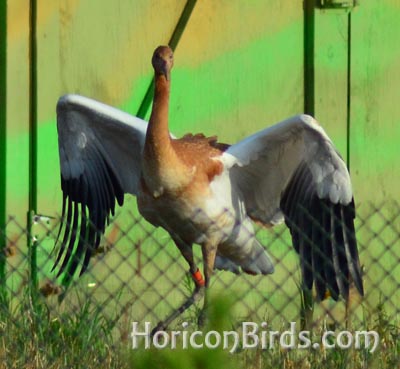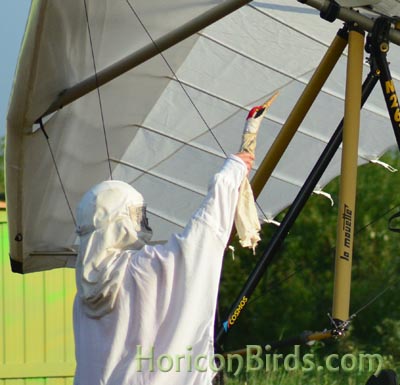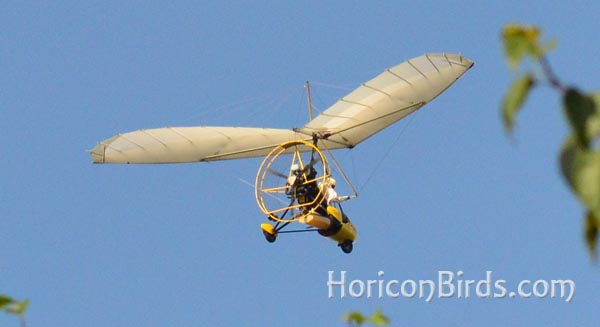|
Operation Migration's Crane Flight Training
by Pam Rotella
29 July 2012 last updated
HoriconBirds.com
The thunderstorm and fog had cleared, but now Doug worried about the erratic breeze -- fast and then nothing, one side of the road and then the other. If there's any wind, the cranes won't fly, he told me. The pilot makes the final decision.
We talked about birding at Horicon Marsh while we waited for the word. Finally a van rolled up with Brooke Pennypacker, one of Operation Migration's ultra-light pilots who would work as a bird handler for the day. He had good news -- the birds would fly. Doug unlocked the gate to the wildlife area, and we all drove down a short dirt road and parked. Halfway through our hike over a wet trail, Doug made a gesture to signal that we were close to the enclosure and could no longer talk above a whisper. It was understood that the cranes could not be imprinted on humans in any way. They must not see or hear me. And they wouldn't see Doug without his crane costume.
I was led to a small room-like duck blind made of hay bales with an opening covered by camouflage netting for viewing. A few holes had been cut in the net for camera lenses. but I wasn't to let my lens stick out too far, Doug whispered. Then he left to prepare the birds for the pilot, who'd arrive shortly.
The ultra-light was heard and then seen. All cranes destined for the ultra-light migration are conditioned to accept the noise, with recordings of the craft played for them even before hatching. After its landing on a short strip of dirt and grass, the birds were allowed to approach the ultra-light and its costumed pilot.
Thus began an amazing opportunity that Operation Migration is offering this year -- the ability to watch their ultra-light pilot train whooping crane chicks for migration.
The pilot greeted the chicks with an adult crane head "puppet," a part of crane handlers' costumes. The chicks seemed eager to please their surrogate parent and practice flying again.
Later I was told that the pilot was Joe Duff, co-founder of Operation Migration and a pioneer in ultra-light guided bird migrations.
Duff had modified his crane costume slightly to safely pilot his craft -- he wore sunglasses as a part of the head covering, and the usual white skirt-like bottom of the costume was pulled up, revealing light blue jeans. He also took his hands out of the costume's white sleeves often to handle his aircraft's controls. But the birds seemed to be focused on the crane head puppet for direction, and not scrutinizing the larger costume.
At the beginning of flight training, Duff played a recorded whooping crane brooding call used by crane handlers -- loudly, to be heard over the noise of the ultra-light engine and sandhill cranes in the area. Two other small aircraft with a sound similar to the ultra-light flew overhead during training, but the crane chicks seemed to understand that they should remain with the ultra-light on the runway.
 The birds had a half-chick, half-adult appearance. While their wings were folded, the birds appeared to be fluffy brown and white whooping crane chicks. But when they spread their wings, they revealed adult white and black whooping crane flight feathers. Whooping cranes are able to fly at about three months of age.
The birds had a half-chick, half-adult appearance. While their wings were folded, the birds appeared to be fluffy brown and white whooping crane chicks. But when they spread their wings, they revealed adult white and black whooping crane flight feathers. Whooping cranes are able to fly at about three months of age.
While the morning's flight training allowed the birds to practice flying, its main focus seemed to be ensuring that the birds would follow the aircraft. There were several exercises up and down the runway, guiding the birds to both walk and fly behind the craft, and even fly in front of it at the pilot's direction.
Operation Migration is using White River Marsh Wildlife Area in Wisconsin to raise and train chicks for the guided whooping crane migration of 2012. Prior to 2011, ultra-light led whooping cranes departed from Necedah National Wildlife Refuge. Unfortunately, birds who returned to Necedah encountered nesting problems attributed to black fly swarms in the refuge. The Whooping Crane Eastern Partnership (a group that includes Operation Migration and the International Crane Foundation) selected new sites for captive-bred whooping cranes beginning in 2011.
In 2011, Horicon National Wildlife Refuge was designated as the site for "Direct Autumn Release" or DAR whooping cranes. The DAR method releases grown whooping crane chicks without migration assistance, and allows newly released cranes to follow older cranes on their migration south. Because the whooping cranes are raised as a group by costumed handlers, it is hoped that these whooping cranes will not think of themselves as sandhill cranes, even if their migration guidance comes from the large sandhill flock at Horicon.
White River Marsh Wildlife Area was selected as the site for ultra-light guided migratory whooping cranes. White River Marsh is more remote than Horicon Marsh, with sandhill cranes and other large birds living in the area. Sandhill cranes could be heard before, during, and after Thursday's ultra-light flight training.
In 2011, the guided migration ended short of its Florida destination, in Alabama, after the FAA famously delayed the migration over a question of whether the organization had violated the agency's rule against compensating ultra-light pilots. In fact, one of my previous appointments to view the flight training this year had been canceled due to an FAA inspection of the runway.
 During Thursday's training, pilot Joe Duff seemed to be using the whooping crane head puppet to direct the birds in flight. At one point, he paused and pointed the puppet up at the sky. That's when a bird returned from flight, and it became clear that the bird had remained in flight even after the pilot had landed. Apparently the gesture of the head puppet had indicated that the bird should return.
During Thursday's training, pilot Joe Duff seemed to be using the whooping crane head puppet to direct the birds in flight. At one point, he paused and pointed the puppet up at the sky. That's when a bird returned from flight, and it became clear that the bird had remained in flight even after the pilot had landed. Apparently the gesture of the head puppet had indicated that the bird should return.
After several runs up and down the runway -- cranes walking behind the ultra-light, cranes flying behind it and in front of it, the pilot exited his craft briefly to lead the chicks back to their enclosure, a camouflage-painted wood structure facing the runway. (More of the structure, the cranes' daily activities, and flight training can be seen on Operation Migration's Live crane cam.)
After the birds were secured and out of sight of their costumed surrogate parents, the three men silently waved good-bye, and Joe Duff flew off in his ultra-light.
More detailed information and field notes about crane migration training can be found on Operation Migration's "In the Field" blog.
 Those who want to see the crane training in person can contact Doug Pellerin, a photographer and volunteer with Operation Migration, at pelican0711@gmail.com. The crane training follows strict rules, and people using the blind must observe the same rules in order for the program to succeed. For example, everyone must arrive on time (currently before 6 a.m.) to keep the birds on schedule, and remain silent to ensure that the cranes remain wild and do not imprint on humans. Photography is allowed without flashes. Bug repellant is recommended, as are boots or shoes that resist water above the ankles. There are no restrooms available on site, although the town of Princeton is a few miles away. Weather and other factors can cause delays -- my own appointment was moved to later dates repeatedly by weather, the FAA inspection, and my own inability to find the correct gate on time during the first visit. Rules for using the blind can be discussed further with Doug.
Those who want to see the crane training in person can contact Doug Pellerin, a photographer and volunteer with Operation Migration, at pelican0711@gmail.com. The crane training follows strict rules, and people using the blind must observe the same rules in order for the program to succeed. For example, everyone must arrive on time (currently before 6 a.m.) to keep the birds on schedule, and remain silent to ensure that the cranes remain wild and do not imprint on humans. Photography is allowed without flashes. Bug repellant is recommended, as are boots or shoes that resist water above the ankles. There are no restrooms available on site, although the town of Princeton is a few miles away. Weather and other factors can cause delays -- my own appointment was moved to later dates repeatedly by weather, the FAA inspection, and my own inability to find the correct gate on time during the first visit. Rules for using the blind can be discussed further with Doug.
Whooping cranes are critically endangered. The International Crane Foundation estimates that 600 whooping cranes are alive today, about one-fourth of those in captivity.
-
All original content including photographs © 2012 by Pam Rotella.
|